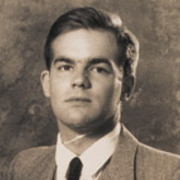
Colin McKenzie
Colin McKenzie's career neatly spans the beginnings of New Zealand cinema: his debut filmmaking efforts occured just a few years after the very first film was shot on local soil, in 1898. McKenzie would abandon work on his final movie, an epic version of Salome, just as the initial burst of local feature filmmaking came to an abrupt stop in 1931.
McKenzie was born in 1888, in the South Island town of Geraldine. His father was an immigrant from Scotland. As a boy, Colin developed a passion for mechanical invention from his uncle, who ran a bicycle store in nearby Timaru.
When travelling picture shows began touring New Zealand around the turn of the century, McKenzie grew increasingly fascinated with film. At age 12 he created moving camera shots by attaching a camera to a bicycle, powering it with a chain connected to the wheel. The DIY Steadicam was the first of many innovations to come.
In 1995 it was revealed that McKenzie may have been responsible for historic footage of Kiwi aviation innovator Richard Pearse, attempting powered flight. Some argue that the footage was filmed in March of 1903, nine months before the Wright Brothers won fame as the first humans to achieve controlled flight.
After leaving home Colin formed the McKenzie Brothers Picture company in 1905, with his younger brother Brooke. The brothers used income from filming weddings to fund attempts at building a camera that could synchronize sound and picture.
They finally succeeded with Colin McKenzie's first full-length feature: 1908 adventure movie The Warrior Season, coincidentally the title of an abandoned feature by directors Peter Jackson and Costa Botes. But the copious use of Chinese language meant limited audiences down under.
McKenzie went on to devote his energies to another cinematic holy grail: inventing a type of film emulsion that would allow images to be seen in colour. Though McKenzie succeeded, legal problems meant his discovery went largely unnoticed at the time.
Sometime in this period McKenzie's relationship with cinema appears to have undergone a transformation: from a fascination with the technology of filmmaking, to mining the artistic potential of the medium.
In 1912 McKenzie began work on a short film adaptation of the biblical story of Salome, the seductress who in some retellings does an infamous dance of the seven veils. Colin played Salome's victim John the Baptist, and his brother Brooke took one of the other major roles. The project was not completed; shortly after marrying one of his co-stars, Brooke enlisted to fight in World War One, and later died in Gallipoli.
In 1919 the Salome project was reborn, this time as a tribute to Brooke's memory. In a valley on the West Coast, construction began on a massive recreation of the city of Jerusalem (incidentally the same locale features in another forgotten piece of Kiwi film history: cautionary lost in the bush tale Such a Stupid Way to Die.) The size of Salome's cast exceeded anything shot on New Zealand soil until Peter Jackson's epic Lord of the Rings trilogy began filming, eight decades later.
Salome was plagued with money problems, changeable weather, and the logistical difficulties of working far from major transport routes. McKenzie was forced to alternate work on his dream project with fee-paying jobs, many of them made with comedian Stan Wilson.
After first teaming up for 1921's Stable Stumbles, McKenzie and Wilson worked together on a series of Stan the Man shorts. The films combined candid camera and vaudeville routines, with the kind of edgy actuality humour later showcased on America's Jackass. The Stan the Man series met an abrupt end after Wilson was set upon by a group of policemen, after throwing a custard pie at Prime Minister Gordon Coates.
The scale of Salome would ultimately force McKenzie to seek funding overseas: initially from American studio boss Rex Solomon, then — after the 1929 Wall Street Crash — thanks to a cash injection from the Soviet Communist party. But the Soviet deal required McKenzie to make major changes to the story, including the removal of all religious references, and Salome's transformation into a convert to collective bargaining.
Faced with artistic compromise and unexpected personal tragedy as he finally neared the end of the project, McKenzie abandoned Salome in 1931, and disappeared overseas.
In 1994 directors Costa Botes and Peter Jackson set off into the West Coast, in search of the original Jerusalem set built for Salome. Their search — chronicled in the eyeopening Colin McKenzie chronicle Forgotten Silver — resulted in the discovery of the original unprocessed Salome footage. In 2025 Costa Botes would add another chapter to the rich Colin McKenzie story, when he published his book Remembering Forgotten Silver. Among other things, the book reveals why McKenzie is sometimes confused with director Thomas Robins.
Kiwi filmmaking legend John O'Shea oversaw the completion of Salome. When McKenzie's final film premiered in a four hour version in September 1995, The NZ Film Commission found themselves marketing a movie that was simultaneously fresh from the lab, and 60 years old.
Profile updated on 13 August 2025
Sources include
Forgotten Silver. Directors Costa Botes and Peter Jackson (WingNut Films, TV One, 1993) Television Programme
Merian C Cooper, Movie Men I Have Known - and Some Dames as Well (New York: Jamboree Books, 1964)
Douglas Jenkin, 'Hunting for Stalin' - The Listener, 17 October 1987